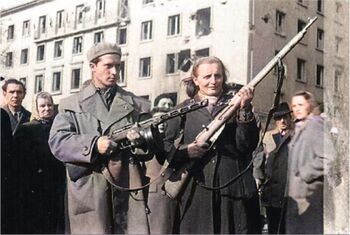Disputation of Siyachia
| Disputation of Siyachia | ||||||||
|---|---|---|---|---|---|---|---|---|
 Secular parties to a religious disputation, Litkov, mid-1703 AN |
||||||||
|
||||||||
| Belligerents | ||||||||
| Kohanim of Bergburg | ||||||||
| Commanders and leaders | ||||||||
|
|
|
||||||
| Strength | ||||||||
| ' | ||||||||
A rabbinical conflict within the Yehudi community of the Siyachia for the right to represent the national community of the Siyachi before the gentile authorities of the Benacian Union. The conflict saw communal preachers firstly attempt to take control of the priesthood and the temples whilst simultaneously dividing amongst themselves as to whether the faith should take a legalist or spiritualist path.
Background
The kohanim shall enjoy the assistance of authority to remove from their numbers any who practice heresy or who have refused the Covenant, whether in public or in their hearts, or whom willingly consort with daemons and other such unclean familiars. Those such as these shall not be suffered to live amongst the Community of the Realm unless they repent and it is the duty of all persons to assist the priesthood in their eradication.
—Article 9.1 of the Covenant
One of the peculiarities of the Benacian Covenant was that the Yehudim, a marginalised and despised community since the fall of Ashkenatza, were obliged to send their priests out into the wider world to perform holy works on behalf of the state. Indeed the kohanim of the Levite tribe were recognised as being amongst the holy orders granted liberty and permitted to travel at will, for the purpose of eradicating such heresies as the worship of Daemons and Umraism[1]
Dating from the Shirerithian conquest of the region in 1657 AN Imperial officials and the Humanist political cadres had been deeply impressed with the moral authority of the so-called rabbis they had encountered amongst the shtetels, and especially with the rigour of the mitzvot that these religious leaders enforced upon those communities. Certainly the sheer breadth of these religiously inspired stipulations, of which there were apparently upwards of 613 separate injunctions, found favour with those in Imperial service, all the way up to the Prince of Modan, Daniyal ibn Daniyal, who despaired of slide towards decadence and heresy that would eventually culminate in the Kalirion Fracture.
By 1703 AN, Adin bin Schummel had been Nasi of the Siyachia for over forty years, surviving the loss of Nackholm, a Kalgachi invasion, and numerous changes of overlord in the process. Although his year of birth was unknown even to himself, as a child of the Green, he was reckoned to be in his early-seventies at this stage, and he was childless. In the Sanhedrin therefore, the rabbinical body which would be obliged to appoint the successor to the spiritual and temporal power in Siyachia, the ambitious began to conspire and factions formed. Without a clear biological heir, the field was open for any candidate of sufficient eminence. A few members of the Sanhedrin stood out, in terms of their learned reputation and scholarly personalities, and other lesser members of the assembly began to drift towards them, either in hope of seeing their own agenda advanced or in the expectation of personal preference. As these personalities, and their acolytes, came increasingly to the fore during the 1690's, divisions began to crow between them that were both ideological and interpersonal in nature. The ambitious do not easily co-exist with one-another when their eyes are ultimately set upon the same prize.
Course of the conflict
For those not familiar with the culture, nor of the lived religious tradition with its legalist and esoteric adherents both at daggers drawn against each other, attempting to understand the nature of the civil conflict that gripped Litkov can be a bewildering and dispiriting affair. Nonetheless it shall be necessary to try.
Sources agree that it was the Zoharites who struck the first blow, and drew indeed the first blood, by taking concealed daggers into the Sanhedrin for yet another debate on this or that theological or ritual subtlety, such as fogs and baffles the agnostic or indifferent mind. Yet, at the utterance of words of a certain invocation, concerning an ancient patriarch willing to sacrifice his only son in order to demonstrate his fidelity to the highest divinity, these zealots in priestly robes drew their knifes from the folds of their voluminous robes and set about slashing at their co-religionists, who recoiled in bafflement and fright.
Notes
- ^ Since all Benacian subjects are required to resubmit themselves to the Covenant on an annual basis, any departure from the requirements of the Covenant, whether in deed, or word, or thought, is by definition an act of heresy, and moreover of treason, against the Highest Divinity.